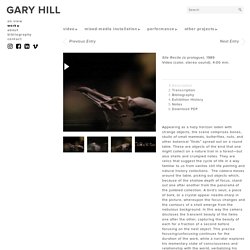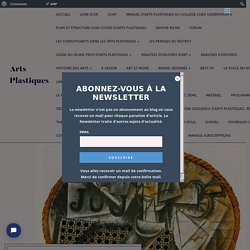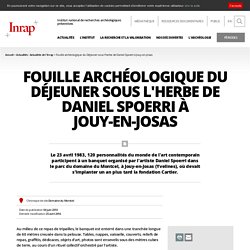

Untitled. Site Recite « Gary Hill. Appearing as a hazy horizon laden with strange objects, the scene comprises bones, skulls of small mammals, butterflies, nuts, and other botanical “finds” spread out on a round table.

These are objects of the kind that one might collect on a nature trail in a forest—but also shells and crumpled notes. They are relics that suggest the cycle of life in a way familiar to us from vanitas still life painting and natural history collections. The camera moves around the table, picking out objects which, because of the shallow depth of focus, stand out one after another from the panorama of the jumbled collection. A bird’s skull, a piece of bark, or a crystal appear needle-sharp in the picture, whereupon the focus changes and the contours of a shell emerge from the nebulous background. In this way the camera discloses the transient beauty of the items one after the other, capturing the beauty of each for a fraction of a second before focusing on the next object.
Voice: Lou Hetler. Nature morte 224 la chaise cann233e, Picasso, 1912. Il y a bien des analyses sur la nature morte à la chaise cannée de PIcasso.

Cette nouvelle analyse apporte un regard neuf sur cette toile qui a fait couler beaucoup d’encre. C’est en travaillant sur la peinture d’Antonello da Messina, que j’ai eu comme une sorte de fulgurance, que j’ai vu une évidence qui jusque là m’avait échappée. Pourquoi peindre cette chaise cannée ? Le geste révolutionnaire consistant à mettre un morceau de toile ciré est depuis longtemps pointé du doigt. Mais la présence de la corde autour de la peinture ne cessait de m’intriguer. C’est en cherchant l’étymologie et l’histoire des cartouches que j’ai pu faire le lien entre les pratiques égyptiennes et l’oeuvre de Picasso. « Un cartouche, dit shenou en égyptien ancien, transcription française du mot égyptien šnw1) est un symbole hiéroglyphique, de forme allongée et fermé par un nœud, qui contient le nom d’un pharaon.
La chaise cannée ne serait-elle pas le siège du pharaon Picasso ? WordPress: J'aime chargement… Fouille archéologique du Déjeuner sous l'herbe. La fouille vingt-sept ans plus tard, à l'initiative de Bernard Müller et sous l'égide de Daniel Spoerri, d'un segment du Déjeuner sous l'herbe est d'un grand intérêt archéologique pour différentes raisons.

D'un point de vue méthodologique, il est intéressant de voir, un quart de siècle plus tard, quels types de vestiges, dans un contexte où une documentation orale, écrite et photographique existe, peuvent être retrouvés et de mettre en évidence les raisonnements qui seront utilisés par les archéologues d'aujourd'hui. Si la Garbage Archaeology, archéologie des vestiges détritiques contemporains, a été pratiquée aux Etats-Unis par William Rathje avec d'importantes conclusions méthodologiques, il n'y a d'expériences similaires ni en Europe en général, ni en France en particulier.
Cette fouille pose aussi, y compris d'un point de vue juridique et administratif, la question de la définition de l'archéologie. Museum of Obsolete Objects. Why the Web Won't Be Nirvana. After two decades online, I'm perplexed.

It's not that I haven't had a gas of a good time on the Internet. I've met great people and even caught a hacker or two. But today, I'm uneasy about this most trendy and oversold community. Visionaries see a future of telecommuting workers, interactive libraries and multimedia classrooms. They speak of electronic town meetings and virtual communities. Baloney. Consider today's online world. Keep up with this story and more by subscribing now What the Internet hucksters won't tell you is tht the Internet is one big ocean of unedited data, without any pretense of completeness. Won't the Internet be useful in governing? Point and click:Then there are those pushing computers into schools.
Then there's cyberbusiness. What's missing from this electronic wonderland?